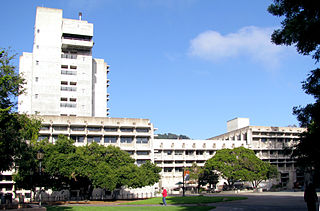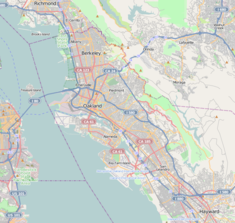
Julia Morgan was an American architect and engineer. She designed more than 700 buildings in California during a long and prolific career. She is best known for her work on Hearst Castle in San Simeon, California.

Bernard Ralph Maybeck was an American architect in the Arts and Crafts Movement of the early 20th century. He worked primarily in the San Francisco Bay Area, designing public buildings, including the Palace of Fine Arts in San Francisco, and also private houses, especially in Berkeley, where he lived and taught at the University of California. A number of his works are listed on the National Register of Historic Places.

The College of Environmental Design, also known as the Berkeley CED, or simply CED, is one of fifteen schools and colleges at the University of California, Berkeley. The school is located in Bauer Wurster Hall on the southeast corner of the main UC Berkeley campus. It is composed of three departments: the Department of Architecture, the Department of City and Regional Planning, and the Department of Landscape Architecture and Environmental Planning.

Northside is a principally residential neighborhood in Berkeley, California, located north of the University of California, Berkeley campus, east of Oxford Street, and south of Cedar Street. There is a small shopping area located at Euclid and Hearst Avenues, at the northern entrance to the university. The Graduate Theological Union is located one block west of Euclid Avenue, in an area nicknamed Holy Hill. The north fork of Strawberry Creek runs southwestward across Northside, mostly culverted under buildings and pavement, to the campus.

La Loma Park is a neighborhood and tract of land located in the Berkeley Hills section of the city of Berkeley, California in the San Francisco Bay Area. The land had been the property of Captain Richard Parks Thomas, a veteran of the American Civil War and Berkeley businessman. Today, it is entirely a residential area The Spanish word loma means "rise/low hill". Although hilly throughout, its average elevation is about 614 feet (187 m).

Hillside Elementary School is a 50,302 ft2 former public elementary school in the hills of Berkeley, California, at 1581 Le Roy Avenue, bordered by Le Roy Avenue, Buena Vista Way, and La Loma Avenue. It is registered as a local historic landmark and is listed on the National Register of Historic Places.
Maybeck Recital Hall, also known as Maybeck Studio for Performing Arts, is located inside the Kennedy-Nixon House located at 1537 Euclid Avenue in Berkeley, California, United States. It was built in 1914 by Bernard Maybeck. The hall seats up to 50 people and was designed upon commission for the Nixon family, local arts patrons who wanted a live-in studio for their daughter Milda's piano teacher, Mrs. Alma Kennedy. The room is paneled in unfinished clear-heart redwood, which contributes to an unusually rich and warm, yet bright and clear acoustic quality. There are two grand pianos in the space: a Yamaha S-400, and a Yamaha C7. Maybeck originally designed the space to accommodate an 1898 7-foot Bechstein.

The Hillside Club is a neighborhood social club established in 1898 by residents of Berkeley, California's newly formed Northside neighborhood to protect the hills from unsightly grading and unsuitable buildings. It took its cue from the Arts and Crafts movement. The building is listed on the National Register of Historic Places since April 16, 2004, under the name "Berkeley Hillside Club"; and listed as a Berkeley Landmark by the city since January 12, 2004.

Charles Augustus Keeler was an American author, poet, ornithologist and advocate for the arts, particularly architecture.

Panoramic Hill is a residential neighborhood of the cities of Berkeley and Oakland, California defined by the homes along and within the access corridor defined by Panoramic Way.

Lilian "Lillie" Belle Bridgman (1866–1948) was an American architect, educator, writer, and scientist. After working first as a science teacher and writer, she changed her profession in mid-life and followed her dream of becoming an architect.

The Berkeley Historical Plaque Project, founded in 1997, is a Berkeley, California non-profit 501 (c)(3) organization whose mission is to document Berkeley’s history through plaques identifying locations of historical import. Sponsors include the City of Berkeley, Berkeley's Landmarks Preservation Commission, the Berkeley Architectural Heritage Association (BAHA) and the Berkeley Historical Society (BHS).

The First Unitarian Church in Berkeley, California is a former church building that was built in 1898. It was designed by Albert C. Schweinfurth, who made unconventional use of Shingle Style architecture, usually applied to homes, in designing a church. It was also highly unusual for a church building in several other ways, including the use of industrial-style metal sash windows, sections of redwood tree trunks as pillars, the strong horizontal emphasis, and a semicircular apse with a conical roof. The building is listed on the National Register of Historic Places, the California State Historic Resources Survey, and is a City of Berkeley Landmark. It has also been known as University Dance Studio and Bancroft Dance Studio for its current use.
John Hudson Thomas (1878—1945) was an American architect, who practiced in Northern California.

The Unitarian Universalist Church of Berkeley (UUCB) was founded as the First Unitarian Church of Berkeley in Berkeley, California in 1891 and moved to Kensington, California in 1961. It is one of the oldest and largest Unitarian Universalist churches on the West Coast and has had many distinguished members, including numerous professors at the University of California, Berkeley. It is highly regarded for its music program as well as its series of renowned ministers and its many avenues for spiritual growth, learning, and social action.
Edna Deakin (1871–1946) was an American designer, and one of the earliest women architects in the United States of America. She is best known for remodeling the "Temple of the Wings" building in Berkeley, California.
Walter Harris Ratcliff Jr. (1881—1978) was an English-born American architect, active in Berkeley, California. His work includes local landmarks and buildings listed on the National Register of Historic Places. He served as Berkeley's first city architect for part of his career and is credited with helping develop the first zoning regulations in the state.
Allanoke Manor or Allanoke, is a historic private residence in Berkeley, California. The main part of Allanoke has the address 1777 Le Roy Avenue, and its former carriage house has the address 2533 Ridge Road, each about one block north of the campus of the University of California, Berkeley. The home was declared by the City of Berkeley, a Berkeley Landmark in November, 1986. It is also known under the variant spelling Allenoke or Allenoke Manor, or as the Robert Sibley House, and the Allen G. Freeman House.

Temple of Wings is a historic Greco-Roman style private estate located at 2800 Buena Vista Way in the La Loma Park neighborhood of Berkeley, California. The main structure was designed by Bernard Maybeck and completed by A. Randolph Monro. It was originally designed as an open-air private home dedicated to modern and contemporary dance. It has been listed by the city as a Berkeley Landmark since January 6, 1992, and is listed in the California State Historic Resources Inventory. It is sometimes known as the Temple of Winds, the Boynton House, and the Charles C. Boynton House.
The Andrew Cowper Lawson House is a historic private residence at 1515 La Loma Avenue in the La Loma Park neighborhood in Berkeley, California, U.S.. It has been listed as a Berkeley Landmark by the city since August 16, 1976.
















